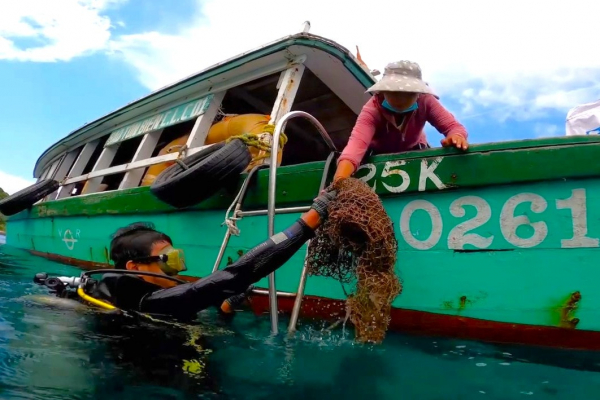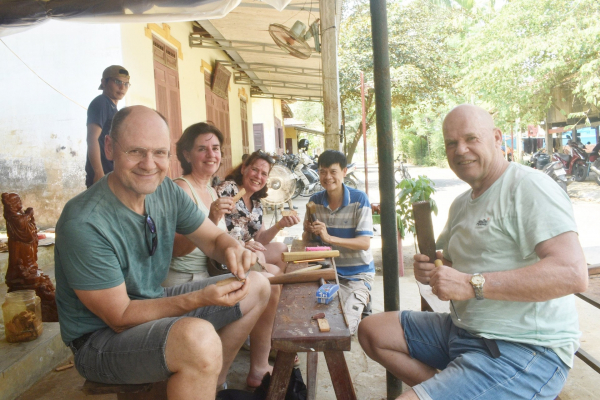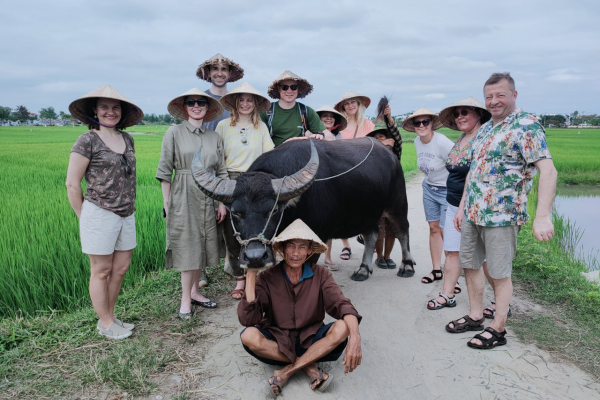In the sixteenth century, this village was settled by the ancestors of the local residents. Through their process of labor and production, carpentry was formed and developed. It has become the famous traditional occupation of Quảng Nam in particular and Vietnam in general, with four main fields: carpentry in construction, carpentry in households, carpentry in boat building, and carpentry in fine art.
With skillful hands, laborious nature in combination with the process of acquiring and selecting external cultural factors, Kim Bồng carpenters have created a Kim Bồng carpentry brand with its own identity, especially carpentry in construction.
Kim Bồng carpenters were recruited by the Nguyễn Dynasty to come to Huế Citadel and build palaces and tombs. In particular, Kim Bồng carpenters made a great contribution to the formation and development of Hội An international commercial port in the seventeenth and eighteenth centuries as well as the conservation of the architectural heritage of the ancient town of Hội An. Currently, Kim Bồng Carpentry Village has been preserved, and the techniques have been handed down with a team of “People’s Artisans”, “Excellent Artisans”, skilled workers and hundreds of young workers who are still taking over the carpentry business, working hard and creating to preserve traditional occupation of the ancestors.
In addition to A World Cultural Heritage Site - Hội An Ancient Town and A World Biosphere Reserve - Chàm Islands, there are also traditional occupation villages, such as Thanh Hà pottery village, Kim Bồng carpentry village and Trà Quế vegetable village. These villages have created Hội An with full colors and unique characteristics that not any locality has. With its long history of development, the residents living in Hội An have gradually developed diverse occupations such as carpentry, pottery making, etc. At the same time, they also made prosperity and bustle for Hội An commercial port from the seventeenth to nineteenth centuries. Kim Bồng Carpentry Village is the that forms the famous traditional occupation called Kim Bồng carpentry.
In Kim Bồng carpentry village, we are able to visualize the process of resident community block formation and the history of traditional handicrafts development in Hội An. At the same time, it is clear that the great contribution of Kim Bồng carpentry to the cultural and architectural heritage of Hội An Ancient Town, through the achievements in carpentry and masonry techniques and the manufacturing ability of local carpenters and masons. These techniques and skills are not only shown in many architectural works and fine artworks but also have their own style, which exists in the locality and some places of the country.
Carpentry includes 4 main groups: carpentry in fine art, carpentry in households, carpentry in construction and carpentry in boat building.
Fine art wooden products are known as kinds of sculptures, paintings, models, etc. Carpentry in households includes wardrobes, beds, tables and chairs. Carpentry in construction includes typical architectural works such as ancient houses, family chapels, communal houses, and pagodas in Hội An.
Carpentry in boat building repairs and builds all kinds of boats like racing boats, riverboats and ocean boats. Besides, in Kim Bồng carpentry village, we will learn more about other traditional occupations that used to develop, such as bamboo knitting, clogs making, mat weaving, mulberry planting, etc., contributing to the formation of a well-known Kim Bồng traditional occupation village.
The rustic rural life of a traditional occupation village has created the character of the Kim Bồng people. They are gentle and simple people. They are hard-working and plain workers with skillful hands. The acquisition and inheritance of the boat building techniques from the Chàm people, the acquisition of civil and belief architecture and the production of household appliances from Chinese and Japanese helped them create many unique products and impressive architectural works which are well-known, creating a unique style and nuance of Kim Bồng carpentry.
Every year, on December 20th of the lunar calendar, Kim Bồng people organize a year-end party and Death anniversary of Kim Bồng Carpentry Village’s founder in Tiền Hiền temple, Hamlet 3 (about 2 kilometers from the village center to the West). On January 6th of the lunar calendar, the workers gather to worship the ancestors in Tiền Hiền temple, which is the place to worship ancestors including 4 families Nguyễn, Huỳnh, Phan and Trương.





 VietNam
VietNam














